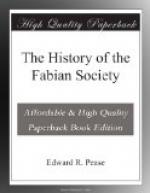The transformation of Mrs. Webb from a student and writer, a typical “socialist of the chair,” into an active leader and propagandist originated in December, 1905, when she was appointed a member of the Royal Commission on the Poor Law. The Fabian Society had nothing to do with the Commission during its four years of enquiry, though as usual not a few Fabians took part in the work, both officially and unofficially. But when in the spring of 1909 the Minority Report was issued, signed by Mrs. Webb and George Lansbury, both members of the Society, as well as by the Rev. Russell Wakefield (now the Bishop of Birmingham) and Mr. F. Chandler, Secretary of the Amalgamated Society of Carpenters and Joiners, the Society took it up. Mr. and Mrs. Webb reprinted the Minority Report with an introduction and notes in two octavo volumes, and they lent the Society the plates for a paper edition in two parts at a shilling and two shillings, one dealing with Unemployment and the other with the reconstruction of the Poor Law, some 6000 copies of which were sold at a substantial profit.
The Treasury Solicitor was rash enough to threaten us with an injunction on the ground of infringement of the Crown copyright and to demand an instant withdrawal of our edition. But Government Departments which try conclusions with the Fabian Society generally find the Society better informed than themselves; and we were able triumphantly to refer the Treasury Solicitor to a published declaration of his own employers, the Lords Commissioners of the Treasury, a score of years before, in which they expressly disclaimed their privilege of copyright monopoly so far as ordinary blue books were concerned, and actually encouraged the reprinting of them for the public advantage. And, with characteristic impudence, we intimated also that, if the Government wished to try the issue, it might find that the legal copyright was not in the Crown at all, as the actual writer of the Report, to whom alone the law gives copyright, had never ceded his copyright and was not a member of the Royal Commission at all! At the same time we prepared to get the utmost advertisement out of the attempt to suppress the popular circulation of the Report, and we made this fact known to the Prime Minister. In the end the Treasury Solicitor had to climb down and withdraw his objection. What the Government did was to undercut us by publishing a still cheaper edition, which did not stop our sales, and thus the public benefited by our enterprise, and an enormous circulation was obtained for the Report.




